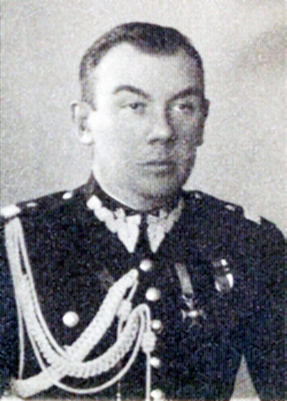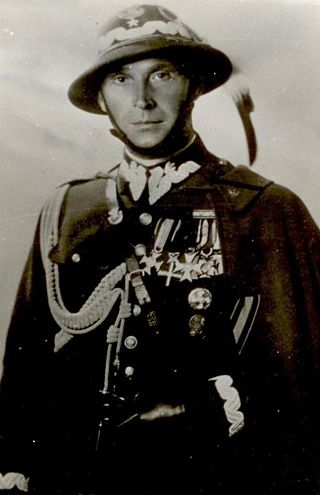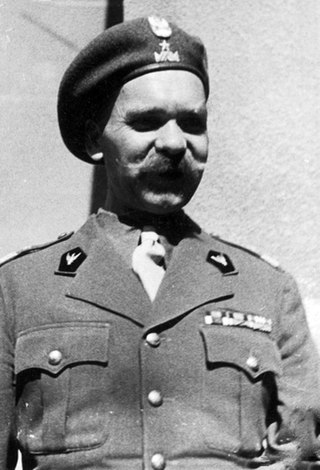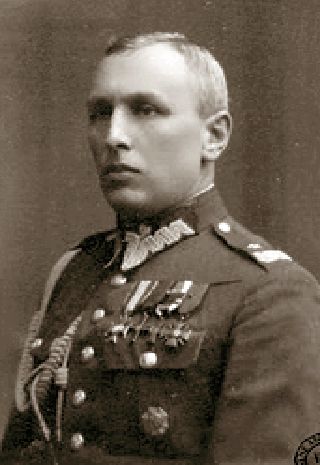
General Michał Tadeusz Tokarzewski-Karaszewicz, Coat of arms of Trąby pseudonym Doktor, Stolarski, Torwid was a Polish general, founder of the resistance movement "Polish Victory Service".

General Stanisław Kopański was a Polish military commander, politician, diplomat, an engineer and one of the best-educated Polish officers of the time, serving with distinction during World War II. He is best known as the creator and commander of the Polish Independent Carpathian Brigade and Polish 3rd Carpathian Infantry Division.

Juliusz Zulauf was a Polish Army brigadier general. A recipient of the Virtuti Militari, he fought with distinction during World War I, the Polish-Ukrainian War, the Polish-Soviet War, and the 1939 invasion of Poland.

Gen. Antoni Chruściel was a Polish military officer and a general of the Polish Army. He is best known as the de facto commander of all the armed forces of the Warsaw Uprising of 1944, as well as Home Army's chief of staff.

Władysław Filipkowski was a Polish military commander and a professional officer of the Polish Army. During World War II he was the commanding officer of the Armia Krajowa units in the inspectorate of Lwów and the commander of the Lwów Uprising. For his merits he was promoted to the titular rank of generał brygady.

Mieczysław Ludwik Boruta-Spiechowicz was a Polish military officer, a general of the Polish Army and a notable member of the post-war anti-communist opposition in Poland.

Józef Rudolf Kustroń was a brigadier general of the Polish Army in the Second Polish Republic, commandant of the 21st Mountain Infantry Division. He was the first Polish general to die during the German invasion of Poland, and the second general officer casualty of the campaign overall; the first was Wilhelm Fritz von Roettig.

Nikodem Sulik-Sarnowski was an officer of the Russian Imperial Army, and Generał brygady of the Polish Army.

Mieczysław Ryś-Trojanowski was a brigadier general of Polish Army in the Second Polish Republic.

Wacław Scaevola-Wieczorkiewicz was a General brygady of the Polish Army in the Second Polish Republic. He fought in World War I, the Polish–Soviet War and World War II.

Stanisław Eugeniusz Skwarczyński (1888–1981) was a soldier of the Austro-Hungarian Army, officer of Polish Legions in World War I, and General brygady of the Polish Army. He fought in several conflicts, including World War I, Polish-Czechoslovak War, Polish-Ukrainian War, Polish-Soviet War and the Invasion of Poland. Furthermore, Skwarczynski was a freemason, member of a Masonic Lodge in Wilno.

Jozef Jaklicz (1894–1974) was a soldier of the Austro-Hungarian Army and the Polish Legions in World War I, and officer of the Polish Army in the Second Polish Republic, nominated to the rank of General brygady. He fought in World War I, Polish–Soviet War, Polish–Ukrainian War and the Invasion of Poland.

Klemens Stanisław Rudnicki was a General of the Polish Army, who fought in World War I, the Polish–Soviet War and the Invasion of Poland. He served in the military from 1914 until 1947.

Stefan Kossecki was a soldier of the Imperial Russian Army, and Colonel of Infantry of the Polish Army in the Second Polish Republic. Captured by the Soviets in 1939, he was murdered by the NKVD in 1940. On November 9, 2004, Kossecki was posthumously promoted to General brygady.
Jan Zygmunt Emil Berek (1896–1986) was a soldier of the Austro-Hungarian Army and Generał brygady of the Polish Army, who fought in World War I, Polish–Soviet War and the Invasion of Poland.

Marian Turkowski (1894–1948) was a soldier of Polish Legions in World War I and Polish II Corps in Russia, and officer, later General brygady of the Polish Army. Altogether, Turkowski served in different military units from 1914 until 1948, with the exception for World War II, during which he was kept as a German prisoner of war at Oflag VII-A Murnau.

Gustaw Paszkiewicz was a soldier of the Imperial Russian Army, and officer of the Polish Army. He entered the military service in 1914, at the age of 22, fighting as Russian soldier in World War I. Paszkiewicz was a soldier until 1952.

Wladyslaw Boncza-Uzdowski was a General brygady of the Polish Army and sports activist, general manager of the Polish Football Association.

Franciszek Józef Sikorski was a Polish engineer, Brigadier general of the Polish Army and a murdered victim of the Katyn Massacre.

Kazimierz Wincenty Iranek-Osmecki was an infantry colonel (pułkownik) in the Polish Army, and colonel in Poland's Home Army (AK). He fought in the 1944 Warsaw Uprising, and was responsible for negotiations between the Home Army and the German Wehrmacht.



















